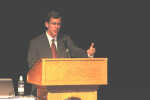Hammons: Donors must have a belief and a connection to the cause and the charity

Editor's note: This is the fifth of a multi-part series covering "High Impact Philanthropy, a 360-Degree View of Planned and Major Gift Fundraising," a day-long training session at Cottey College in Nevada.
By Floyd Jernigan
Nevada Daily Mail
People have money to give, but where they choose to do that can be based on a wide variety of factors, said Brian Hammons, president and CEO of Hammons Products Co. of Stockton, Mo., a commercial processor of American Black Walnuts.
Hammons was one of the featured speakers during the philanthropy seminar at Cottey College.
His presentation, "A donor's perspective on giving," began with noting that $6.2 trillion will be transferred from one generation to the next during the next 10 years, with $135 billion of that changing hands in Missouri.
"Baby boomers will be passing along their accumulated wealth, either passively or actively deploying those funds," Hammons said. "They will be looking for ways to make a difference and for stewardship opportunities."
And as they do that, they will base their giving on their belief system, added Hammons.
"This is based on their faith and a stewardship of what we have. That's the core of why some people give," he said.
"They will give based on the cause. For others, it's a matter of heart, a compelling need that speaks to us."
To tap those funds, he told the audience of non-profits, facilitators, and education and community institutions and organizations; there are three areas that groups must address.
"You must have an organization capable of meeting the donor's need, with both vision and a plan to carry it out," Hammons said.
"There must be a connection. Trust is vital and a critical component for people.
"There must be a track record of showing results of these donations.
"And there needs to be an opportunity, an invitation to contribute, a personal discussion."
Seventy-two percent of charitable gifts are made by individuals, said Hammons. "And those people are more able to respond to causes. There is a human need that is compelling and requires help."
Hammons then listed some of the reasons that people don't donate.
"People were asked, what turns you off to donating," he said. "A lot of the requests are impersonal.
"There is a lack of a plan for meeting the need. And there is a perception that the entity that is asking for the help is not capable of executing that plan," for the success of the donation.
To counter that, organizations and non-profits must have programs that "address the long-term solutions," Hammons said.
"They must address what percentage of the gift will be used in administration and fundraising costs and show that the dollars given are going to help the cause."
In conclusion, Hammons said it's important to "have a message that inspires, to state a clear description of the cause, a plan to address that need, and tell the donor how that donor can be a part of helping."
